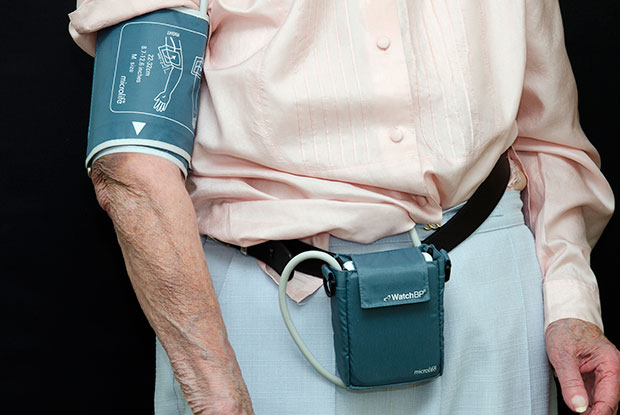What Are the Guidelines for ABPM in Adults?

Ambulatory Blood Pressure Monitoring (ABPM) has revolutionized the way healthcare professionals assess and manage hypertension, providing more accurate and reliable data compared to traditional office-based readings. For adults, ABPM offers a detailed, 24-hour snapshot of blood pressure fluctuations during daily activities and sleep. This allows for a more comprehensive understanding of cardiovascular risks, enabling better diagnoses and more targeted treatment plans. However, proper use and interpretation of ABPM require adherence to specific guidelines.
In this article, we will explore the guidelines for ABPM in adults, including when to use the procedure, how to interpret the results, and what specific protocols must be followed to ensure reliable data. We will also look into the role of modern ABPM devices, such as those available at https://hingmedical.com/product-category/hospital-abpm/, which have made home-based monitoring more accessible and accurate.
What is Ambulatory Blood Pressure Monitoring?
ABPM is a technique used to measure blood pressure continuously over 24 hours, whether the patient is awake, working, or sleeping. The ABPM device is typically worn around the waist, with a cuff on the upper arm that inflates at regular intervals (usually every 15-30 minutes during the day and every 30-60 minutes at night).
The primary benefit of ABPM is that it offers a more accurate picture of blood pressure trends, capturing spikes that may occur during the day due to stress, physical activity, or sleep disturbances. This contrasts with the occasional, often inaccurate readings taken during a single doctor’s visit. ABPM is invaluable for diagnosing conditions such as white-coat hypertension, masked hypertension, and nocturnal hypertension.
When is ABPM Recommended?
Guidelines suggest that ABPM should be used in specific clinical situations where traditional blood pressure measurements may not provide a complete or accurate diagnosis. According to the European Society of Hypertension (ESH) and the American Heart Association (AHA), the following scenarios warrant the use of ABPM:
- White-Coat Hypertension: Some patients experience elevated blood pressure in clinical settings due to stress or anxiety. ABPM can differentiate between true hypertension and white-coat hypertension, where the patient’s blood pressure is normal outside of the clinical environment.
- Masked Hypertension: This occurs when blood pressure appears normal during a doctor’s visit but is elevated during daily activities. ABPM is essential in identifying this condition, which may go unnoticed with traditional methods.
- Nocturnal Hypertension: Blood pressure that remains elevated at night or fails to drop during sleep (a condition known as “non-dipping”) is associated with higher risks of heart disease and stroke. ABPM is the only reliable way to detect nocturnal hypertension.
- Evaluating Treatment Effectiveness: For patients already undergoing treatment for hypertension, ABPM can help assess how well medications are controlling blood pressure throughout the day and night. This can guide physicians in adjusting medication dosages or recommending lifestyle changes.
- Suspected Hypertensive Emergencies: In cases where doctors suspect that sudden spikes in blood pressure may be leading to acute symptoms such as headaches, vision changes, or chest pain, ABPM can help monitor these dangerous fluctuations in real time.
- Blood Pressure Variability: Some patients exhibit large fluctuations in blood pressure over short periods. ABPM provides a continuous record, helping healthcare providers understand the variability and decide on appropriate interventions.
- Resistant Hypertension: For patients who are on multiple antihypertensive medications but still have uncontrolled blood pressure, ABPM can provide insights into whether their readings reflect true treatment resistance or if factors like white-coat hypertension are playing a role.
How is ABPM Conducted?
To ensure the most accurate results, patients and healthcare providers must adhere to established guidelines for conducting ABPM. The ABPM device is typically easy to use, but there are specific steps and protocols that must be followed.
1. Proper Device Selection
The first step is choosing an appropriate ABPM device. Devices like those from Hing Medical are designed for both clinical and home-based use, offering features like automatic inflation, data storage, and the ability to track readings over 24 hours. These devices are lightweight and comfortable to wear, which is critical for ensuring patient compliance.
2. Patient Preparation
Patients should be adequately informed about the process and how the ABPM device works. They should be instructed on how to wear the monitor correctly, ensuring that the cuff is properly positioned on the upper arm and that the device is securely attached to their clothing.
They should be advised to continue their normal daily activities but avoid vigorous exercise or actions that may interfere with the cuff, such as excessive arm movement. It is also essential to remind patients to relax and avoid speaking during cuff inflation to prevent inaccurate readings.
3. Monitoring Period
The typical monitoring period for ABPM is 24 hours. During this time, the device will take readings at intervals set by the healthcare provider. Generally, readings are taken every 15-30 minutes during the day and every 30-60 minutes at night. Patients should keep a diary noting significant activities, meals, stressors, or periods of rest, as these can help contextualize abnormal readings.
4. Data Collection and Analysis
Once the 24-hour monitoring period is complete, the ABPM device is returned to the healthcare provider, who will download the recorded data for analysis. Most modern devices allow for easy data transfer, with some offering the ability to sync with apps or computers for real-time monitoring.
The data will provide a detailed report of blood pressure trends, including average daytime and nighttime readings, and will flag any abnormalities such as elevated nighttime blood pressure or morning surges.
Interpretation of ABPM Results
Understanding ABPM results requires careful interpretation of the data, taking into account not only the blood pressure readings but also the patient’s activities during the monitoring period. Key measurements include:
- Mean Daytime Blood Pressure: This reflects the average blood pressure during waking hours. In adults, a mean daytime reading of 135/85 mmHg or higher is considered hypertensive.
- Mean Nighttime Blood Pressure: This represents the average blood pressure during sleep. A reading of 120/70 mmHg or higher at night is indicative of hypertension.
- Overall 24-Hour Average: The combined average of both daytime and nighttime readings. A 24-hour average of 130/80 mmHg or higher is considered hypertensive.
- Nocturnal Dipping: In healthy individuals, blood pressure typically decreases by 10-20% during sleep. If this dip is less than 10%, or if blood pressure rises at night (a “reverse dipper” pattern), it could signal a higher risk of cardiovascular complications.
- Morning Surge: Blood pressure tends to rise naturally upon waking. However, an exaggerated morning surge is linked to an increased risk of stroke and heart attack. ABPM can help identify abnormal surges.
The results are compared against established thresholds for daytime, nighttime, and 24-hour averages to determine if the patient has hypertension. The data also helps healthcare providers evaluate the effectiveness of any ongoing treatments and make necessary adjustments.
ABPM Guidelines for Special Populations
While the general ABPM guidelines for adults apply to most patients, certain populations may require specific considerations:
1. Older Adults
In older adults, ABPM can be particularly valuable as blood pressure tends to fluctuate more with age. Special attention should be given to nocturnal hypertension, which is more common in this age group and is associated with increased cardiovascular risk. ABPM can also help avoid overtreatment in elderly patients who may have white-coat hypertension.
2. Patients with Chronic Kidney Disease (CKD)
Patients with CKD often exhibit abnormal blood pressure patterns, including nocturnal hypertension and a lack of nocturnal dipping. ABPM is recommended for these patients to better manage blood pressure, as maintaining optimal control can slow the progression of kidney disease.
3. Diabetic Patients
For diabetic patients, ABPM is critical in detecting early signs of hypertension, particularly masked hypertension, which is common in this population. Continuous monitoring allows for better management of blood pressure, reducing the risk of complications such as heart disease and kidney failure.
Benefits of Following ABPM Guidelines
Adhering to ABPM guidelines ensures that the procedure is conducted accurately and that the data collected is reliable. This leads to several important benefits for both patients and healthcare providers:
1. Accurate Diagnosis
ABPM provides a more comprehensive picture of blood pressure fluctuations, allowing for the accurate diagnosis of conditions like white-coat hypertension, masked hypertension, and nocturnal hypertension. This accuracy helps avoid unnecessary treatments or under-treatment of hypertension.
2. Personalized Treatment Plans
With ABPM data, healthcare providers can develop more personalized treatment plans based on the patient’s unique blood pressure patterns. This can involve adjusting medications or recommending lifestyle changes to improve blood pressure control.
3. Improved Monitoring of Treatment Efficacy
For patients already on blood pressure medication, ABPM can assess how well the treatment is working throughout the day and night. This allows for more precise adjustments to treatment regimens, ensuring that blood pressure remains within target ranges at all times.
4. Long-Term Cardiovascular Health
Early and accurate detection of abnormal blood pressure patterns through ABPM can prevent the development of serious cardiovascular complications. By following guidelines and conducting ABPM when necessary, patients can manage their blood pressure more effectively, reducing their risk of heart disease, stroke, and kidney damage.
Conclusion
Ambulatory Blood Pressure Monitoring (ABPM) is an invaluable tool for diagnosing and managing hypertension in adults. By following established guidelines for when and how to use ABPM, healthcare providers can ensure that the data collected.For healthcare professionals seeking reliable and advanced Ambulatory Blood Pressure Monitoring (ABPM) solutions,hingmedical.com/product-category/hospital-abpm offers a range of high-quality devices designed to meet clinical needs. Their selection of hospital-grade ABPM devices combines cutting-edge technology with user-friendly features, ensuring accurate and comprehensive blood pressure monitoring. These devices are engineered for precision, comfort, and ease of use, providing continuous, 24-hour blood pressure readings that help in diagnosing and managing hypertension effectively. Whether used in a clinical setting or for home monitoring, Hing Medical’s ABPM solutions support healthcare providers in delivering exceptional patient care by offering detailed insights into blood pressure trends and fluctuations.



